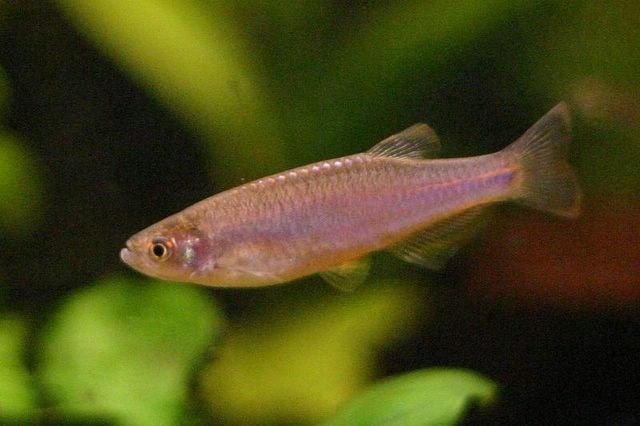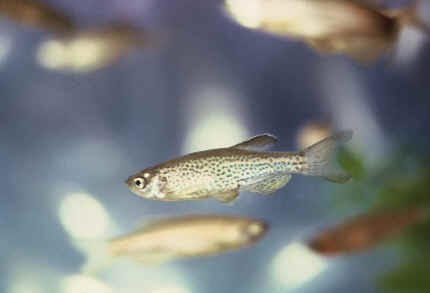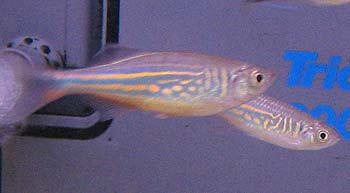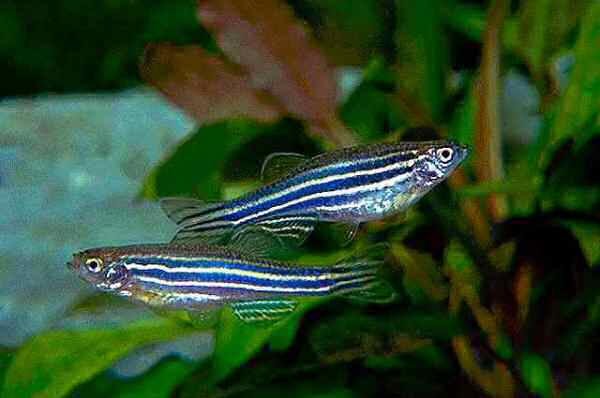| Data Sheet |
| |
| Scientific Name: | Brachydanio ~ | |
| Other Names: | Zebra Danio, Pearl Danio, Leopard Danio, Gold Danio | |
| Family: | Cyprinidae | |
| Origin: | Asia, | |
| Adult Size: | 2 inches (6cm) | |
| Social: | Peaceful schooling fish | |
| Lifespan: | 5 years | |
| Tank Level: | All |
|
| Minimum Tank Size: | 20 gallons | |
| Diet: | Omnivore, eats most food | |
| Breeding: | Egg layer | |
| Care: | Easy - hardy fish that eats anything. | |
| Ideal pH: | 6.5-7 | |
| Temperature: | 64-74 F (18-24 C) | |
| Tank setup: | Danio should be provided with plenty of lighting and an open swimming space, together with some vegetation. | |
| Sexing: | Females are usually larger and have a fuller body than males. | |
| Description:All Danios are torpedo-shaped fish, usually small (except for giant danio), and very fast. Some Danios, such as the Zebra Danio and the Leopard Danio, have very beautiful body patterns. Habitat/Care:Danios are omnivorous, accepting almost any foods. Although undemanding in diet, they particularly enjoy small live or frozen inverts, and fresh vegetable matter. Mixing with other fishes:Danios are highly peaceful fish that can be mixed with most other fish of similar size. A schooling fish, it prefers to be in groups of six or more. Because they are very fast, they tend to be among the first to feed at meal times, so you need to ensure that slower eaters have some food to eat. Diet:Danios are omnivorous. In the wild, these fish consume various small aquatic insects, crustaceans, worms as well as plankton. For this reason, they can be used to reduce mosquito larvae populations in ponds and ditches. Floating flake food and freeze dried blood worms are popular food for Danios. Both of these foods are available in most stores that sell pet fish. Danios also relish an occasional feeding of a few live Black Worms and live or frozen brine shrimp. Some text noted that Danios are relatively fast, and are often among the first to feed. Breeding:Danios are somewhat unique, as they are quite loyal to their chosen mate. Mated pairs remain together, and rarely spawn with others, even if one mate dies. The breeding tank should be set up with shallow water, approximately six inches deep. Furnish the tank with fine-leaved plants or a spawning grid on the bottom. Course gravel works well, as the eggs will fall between the gravel pieces and will be protected from the adult fish, which will readily eat their own eggs. Spawning requires temperatures of up to 78 degrees F, and can be trigged by raising the water a couple of degrees near dawn, when spawning normally occurs. 300 to 500 eggs will be scattered across the bottom and on the plants. Remove breeders after spawning, as they will consume the young. The fry will hatch in two days. They are very tiny, and can easily be lost when changing water, so take care when maintaining the grow-out tank. Feed the young commercially prepared fry food, or finely crushed dry foods. Powdered egg may also be added to the fry food to promote growth. |
DiseaseDanio are susceptible to Oodinium, (Velvet disease).
Variants:
| |
Photo Galley
Got a photo? Contact me.
 leopard Danio |  Pearl Danio | |
 Leopard Danio |  Giant Danio | |
 Hi-Fin Zebra Danio |  Zebra Danio | |
References Cited:
1. Zebra Danio, [Online], Available http://freshaquarium.about.com/cs/cyprinids2/p/zebradanio.htm
2. Danios for Sale, [Online], Available http://www.aquariumfish.net/catalog_pages/cyprinids/danios.htm
3. Zebra Danio, [Online], Available http://en.wikipedia.org/wiki/Brachydanio_rerio
4. Velvet (Oödinium pilularis), [Online], Available http://freshaquarium.about.com/cs/disease/p/velvet.htm
5. Giant Danio, [Online], Available http://en.wikipedia.org/wiki/Danio_aequipinnatus





























No comments:
Post a Comment